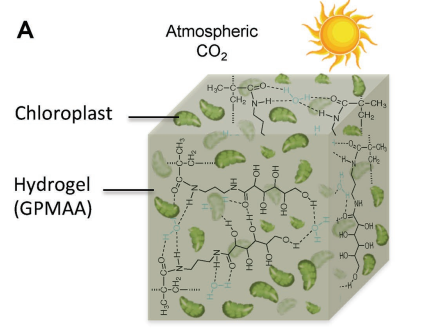研究人员巧妙的将植物的光合作用机制转接到水凝胶材料中,实现了可吸收转化空气二氧化碳的自修复水凝胶材料,可以观察到水凝胶材料随着时间延长的增长情况。大致的原理这样:
反应体系由叶绿体、3-氨基丙基甲基丙烯酰胺(APMA)、水、空气、光照等组成,模拟细胞环境。。。过程是:在植物分离出的叶绿体光合作用下,将空气中二氧化碳被转化成葡萄糖内脂(GL),然后GL与3-氨基丙基甲基丙烯酰胺(APMA)在光作用下继续发生反应,并光聚聚合形成丙烯酸酯水凝胶材料。整个过程材料是不断自我增长、强化的过程,通过吸收二氧化碳进行转化成自身材料实现自身的修复功能。


如果能解决叶绿体有效期时间短(从植物中分离出来)或者找到类似功能的替代物,本研究将具有广泛的应用前景。
Seon‐Yeong Kwak Juan Pablo Giraldo Tedrick Thomas Salim Lew Min Hao Wong Pingwei Liu Yun Jung Yang Volodymyr B. Koman Melissa K. McGee Bradley D. Olsen Michael S. Strano
Abstract
Plants accumulate solid carbon mass and self‐repair using atmospheric CO2 fixation from photosynthesis. Synthetic materials capable of mimicking this property can significantly reduce the energy needed to transport and repair construction materials. Here, a gel matrix containing aminopropyl methacrylamide (APMA), glucose oxidase (GOx), and nanoceria‐stabilized extracted chloroplasts that is able to grow, strengthen, and self‐repair using carbon fixation is demonstrated. Glucose produced from the embedded chloroplasts is converted to gluconolactone (GL) via GOx, polymerizing with APMA to form a continuously expanding and strengthening polymethacrylamide. The extracted spinach chloroplasts exhibit enhanced stability and produce 12 µg GL mg−1 Chl h−1 after optimization of the temporal illumination conditions and the glucose efflux rate, with the insertion of chemoprotective nanoceria inside the chloroplasts. This system achieves an average growth rate of 60 µm3 h−1 per chloroplast under ambient CO2 and illumination over 18 h, thickening with a shear modulus of 3 kPa. This material can demonstrate self‐repair using the exported glucose from chloroplasts and chemical crosslinking through the fissures. These results point to a new class of materials capable of using atmospheric CO2 fixation as a regeneration source, finding utility as self‐healing coatings, construction materials, and fabrics.
加入水材料交流群,请联系小编的微信号2322739585